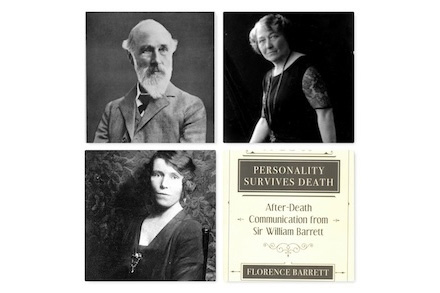
A Peek into One of Many White Crow Books
Personality Survives Death: After-Death Communication from Sir William Barrett, by Florence Barrett, White Crow Books, 2020, 180 pages (reproduction of a 1937 book by Longsman, Green & Co., London)
After his death in 1925, Sir William Barrett, a distinguished British physicist (upper left photo), began communicating with his wife, Florence Barrett, a physician and dean of the women’s college of medicine in London (upper right), through several mediums, including trance medium Gladys Osborne Leonard (lower left). He told her that he had to learn how to slow down his vibration in order to communicate with her. “Sometimes I lose my memory of things from coming here,” he continued. “I know in my own state but not here. In dreams you do not know everything, you only get parts in a dream. A sitting is similar; when I go back to the spirit world after a sitting like this I know I have not got everything through that I wanted to say. That is due to my mind separating again.”
A physics professor at the Royal College of Science as well as a renowned inventor, Barrett was one of the pioneers of psychical research. It was his idea to form the Society for Psychical Research (SPR) in London in 1882. However, since he was living and teaching in Dublin, Ireland at the time, he was not able to take an active part in managing the Society. He also encouraged Professor William James of Harvard to organize the American branch of the SPR in 1884. He edited the SPR Journal from 1884 until 1899 and served as president of the SPR in 1904.
Initially, Lady Barrett was skeptical and asked for proof that the communicator was her late husband. Sir William responded by mentioning a tear in the wall paper in the corner of his room and a broken door knob, both of which they had discussed a month or so before his death, and the fact that they had now been repaired. This was especially evidential to Lady Barrett.
For further verification, Lady Barrett asked Sir William to tell her the circumstances of his death. He accurately responded that he had died in the armchair in the drawing room as Lady Barrett accompanied a visitor to the front door downstairs. She discovered his lifeless body upon her return. Lady Barrett was certain that Mrs. Leonard could not have known such detail. Sir William added that when he passed over he had no pain at all and that he was at once met by his mother and father and others.
Sir William stressed that he was not communicating to give evidence of his survival but to explain as well as he could the conditions he encountered in his new life. “It seems to me from where I am most people are not even struggling but meandering on purposelessly, blindly, because they have no definite philosophy as a starting point,” Sir William communicated, also commenting that he felt his fellow physicist Sir Oliver Lodge “is nearer the bigger, greater aspect of things than most.” He went on to explain that in the earth body we have the separation of subconscious and conscious and that when we pass over they join and make a complete mind that knows and remembers everything. However, when he brings himself back into the physical sphere, the conscious and the subconscious again separate and he forgets much. “I cannot come with my whole self, I cannot.”
When Lady Barrett asked him to elaborate, Sir William pointed out that he has a fourth dimensional self which cannot make its fourth dimension exactly the same as the third. “It’s like measuring a third dimension by its square feet instead of by its cubic feet,” he continued, “and there is no doubt about it I have left something of myself outside which rejoins me directly I put myself into the condition in which I readjust myself.”
Sir William explained that when he was in his own sphere he would remember a name, but when he came into the conditions of a sitting he could not always remember it. “The easiest things to lay hold of are what we may call ideas,” he communicated. “A detached word, a proper name, has no link with a train of thought except in a detached sense; that is far more difficult than any other feat of memory or association of ideas.”
Making the transition from the material life to the spirit life was not all that difficult for him, he told his widow. “After I had rested for a little while, I felt like a boy on a holiday exploring a new wonderful place of which I had heard and conjectured and pictured, but which more than came up to my expectations,” he stated, adding, however, that there are lower planes than the one on which he exists, depressing places peopled with souls who have had no or little consciousness of the spiritual self during the earth life, no independent life in the creative mental self. His primary aim, he continued, was to help humans grasp the importance of developing the soul or etheric life before they leave the body, so that they can avoid residence in these lower planes. “The spiritual life must be formed in the physical life,” he stressed, “that is the object for which God created the Earth and the physical life thereon.”—MET
|